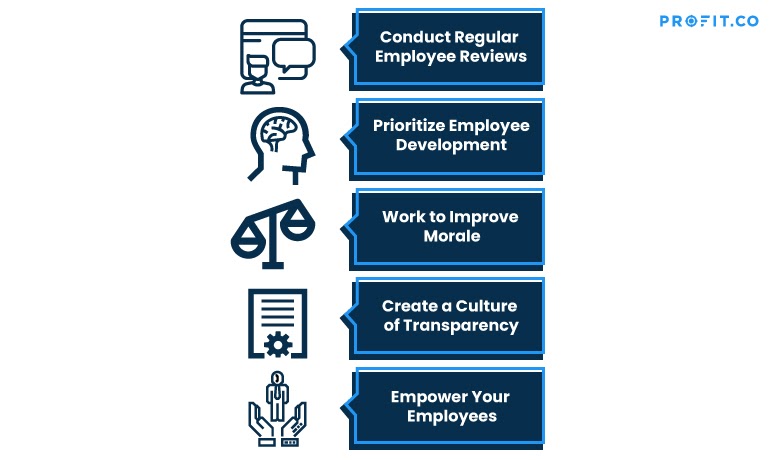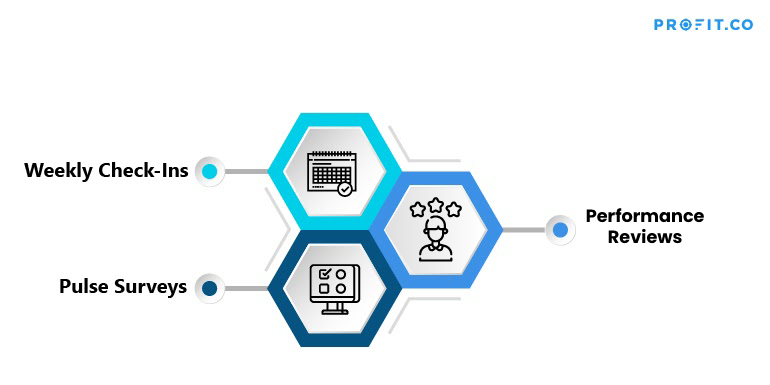In recent years, managers and other business executives have started implementing more measures to improve employee performance in the workplace. With costs of recruitment rising, it has become increasingly vital for businesses to improve the performance of the employees they already have, vs. firing them for poor performance and replacing them.
However, with new performance management trends surfacing every year, it can be tricky to know exactly what methods will improve employees’ performance in your organization.
Employee Performance vs. Employee Productivity
One of the biggest areas of confusion when people discuss employee performance is that it’s often confused with employee productivity. While the differences between the two are subtle, it’s important as an HR manager to understand the difference.
Employee performance is how well an employee can accomplish their responsibilities based on the expectations of a business. The key phrase with this is the “expectations of a business”, as many employees can face different expectations depending on who they are doing business with.
For example, an employee in sales may be expected by the business to reach a set sales quota each month. However, they’ll also be talking with customers, who will expect that salesperson to only sell them things that they need.
In this example, employee performance is managed based on the business’ expectations (to generate sales), and not customer expectations (to only sell necessary products).
On the other hand, employee productivity is how efficiently an employee completes his responsibilities.
To continue with the example of a sales employee– the number of sales a salesperson closes compared to the number of calls they make is an indicator of employee productivity.
It’s important to remember that both of these measures should be used as part of a well-rounded performance management program, but they shouldn’t be confused as the same metric.
Why do employees underperform?
When you’re looking into methods to improve employee performance throughout your organization, you should first understand the reasons why employees may underperform at some point in their careers. When you know the underlying reasons behind underperformance, you can then prescribe an effective solution.
Personal Issues
Employees aren’t robots, and no matter how much HR and managers ask them not to bring their personal problems into work, it can be extremely difficult to focus when domestic or personal issues are taking up their mental bandwidth. In these cases, the best-course of action would be to offer support and adjust their workload while they’re dealing with such a crisis. Employee Productivity Rate (EPR) may be the right KPI to help you to identify employees who choose to be unproductive, as opposed to those who cannot be anymore.
Inadequate Training
If an employee hasn’t had all the training time that they need, or have entered a job underqualified, then they might be struggling to fulfill their responsibilities. If an employee is struggling due to a lack of training, then their personal development plan must make time for training and for learning the necessary skills to help to improve their performance.
Unclear goals and hierarchy
In order to perform to the best of their abilities, employees must have a clear idea of their goals in their job, and also know who they report to. During a crisis, a change of business direction, or a restructure, employees can become confused when it comes to these vital aspects of their job. In these cases, early intervention to update employees of their roles and responsibilities can help restore performance levels.
Businesses require transparent communication of the corporate goals throughout the organization with which every employee can align his goals and work. A business’s strategic goals are best executed within a well-defined operational framework such as OKRs. OKRs have been an incredible tool powering some of the most innovative companies of this century.
Understanding the performance management cycle
Improving employee performance is at the heart of performance management, which is why it’s important to understand where each performance improvement measure sits as part of the cycle.
It’s worth noting that there’s no set duration for this cycle, so it can last as long or as short between each phase as works for you and your employees.
Stage 0
Before any performance management cycle begins both the manager conducting the performance review and the employee being reviewed should understand the business’ goals and values. Some managers like to have this defined in the performance management documentation that both they and their employees can access, while others will have an initial meeting with their employees to define those goals and the employee’s responsibilities in regard to them.
Plan
At this stage, you and your employees will work together to set SMART goals for their performance. This will form and update their personal development plan, which you’ll use going forward to manage their performance.
Act
With a plan in place, the employee will carry out their standard job role and work towards the goals that you set together.
Track
You’ll then track the employee’s progress and give them regular feedback, ideally through one-to-one and check-in meetings to understand how they’re progressing. You’ll also use these meetings to help them overcome any obstacles in the way of them reaching their goals and coach them through any roadblocks.
Review
At the end of a defined period of time, you and your employees will meet to review their achievements, identify what they’ve learned, and agree on how to move forwards. You’ll also use this time to help your employees understand their career goals so you can help them work towards those aspirations.
Sureshots for employee performance improvement

With all of that in mind, there is a myriad of methods that you can implement to improve employee performance throughout your organization.
1. Conduct regular employee reviews
One of the best ways to improve employee performance at your organization is to make sure that every employee can access regular reviews. This will undoubtedly work differently for every company, but studies have shown that employees whose managers communicate with them regularly are three times more engaged at work, meaning that one standardized annual review is no longer helping employees to thrive.
It is highly recommended that employee reviews be held quarterly. However, implementing a culture of regular feedback delivery is the best way to keep your employees engaged. With 96% of employees saying that they want to hear feedback more regularly, you can’t afford not to communicate with your employees.
There’s no way to get better at something you only hear about once a year
Regular employee reviews are also a great way for managers to deal with roadblocks and obstacles in a timely manner and sometimes before they even happen. The purpose of feedback is to either recognize good behavior or encourage employees to work on undesirable behavior, So, it’s important that problems are addressed as they occur– not months later.
When employees only get praised for their efforts or hear of their shortcomings once a year, the event that is in discussion has often long passed and is a distant memory. In which case, it can be difficult for employees to remember exactly what behaviors they performed, or even why they performed them.
This is the main argument for conducting regular employee evaluations. Whether your organization does them quarterly or monthly, or if they encourage check-in meetings in-between, it’s vital that you integrate this consistent feedback into every employee’s personal development plan.
2: Prioritize employee development
In that vein, prioritizing employee development is another important factor in improving performance.
According to Sequioa Cap, 22% of staff turnover occurs within the first 45 days of employment, and one in three employees will leave their company within their first year of employment. Engaging employees from the minute they step through the door is vital, as these statistics show that the first few months of employment are crucial when it comes to reducing turnover.
One of the main drivers behind these astounding turnover rates is a lack of training. In a long-term research project, Middlesex University found that 74% of employees felt that they couldn’t achieve their full potential at work because of a lack of training and development. Many employees are starting new jobs, however, they’re finding the training that they were promised is either severely lacking or non-existent.
To combat this, your organization needs to have a 90-day performance review template that each manager can use to support new hires. Managers need to communicate this procedure during onboarding. Not only will this mean that new employees have the chance to express their concerns early, but it ensures that managers can address any lack of training before an employee has a chance to become demoralized.
3: Work to improve morale
A long-term study found that companies that highly appreciated their employees grew 682% in revenue over 11 years, while those without a thriving company culture only grew by 166%. This just goes to show that a company culture where employees are valued significantly correlates with profitability.
Employee morale can’t be understated as a driver for improved performance, which is why you need to prioritize morale-boosting measures in your organization if you’re looking to keep employees engaged and satisfied.
As with most employee performance measures, the way you improve morale in your company will vary depending on your industry and organization. If you’re not sure where to start, here are some creative ideas that modern companies have implemented to improve employee morale:
- Introduce an Employee Advocacy Program
- Recognize employees on social media and in internal communications
- Celebrate work anniversaries
- Offer discounted products and programs
- Company outings voted for by employees
4: Create a culture of transparency
One of the largest boosts you can give to employee performance and morale is to create a culture of transparency throughout your organization. Ensuring that communication between employees, managers, departments, and even leaders on the highest level is clear and attainable for everyone can go a long way to helping employees to feel connected to the business and their work.
Not only that, but employees should understand the purpose of their job and their role within the company. A great way to do this is by making employee evaluation forms and employee review questions available at all times following a performance review. This helps employees to stay focused on their role and responsibilities, and it also means that their goals for work evaluation are quickly accessible if they feel they have a lack of direction. Transparency, as well as assisting employees with their goals if they feel stuck, can help to keep employees engaged and working at peak performance.
It goes without saying that employee evaluation comments should stay between an employee and their manager, but many employees in modern companies are hampered by this lack of basic transparency.
Opening a channel of regular communication between employees and their managers is only the first step in fostering a culture of transparency, but it’s one of the biggest steps an organization can take.
5: Empower employees
All too often, employees can feel hamstrung by a persistent culture of micromanagement at the hands of managers with control issues. While some employees will inevitably improve their performance under the watchful eyes of a manager who coaches and guides them to improve, others will feel stifled by a lack of freedom.
To improve employee performance, employees should have the opportunity for greater levels of autonomy and ownership over their work, particularly for employees who have been with a company for a longer period of time.
This point circles back to the one discussed earlier on employee development, as this level of autonomy should always be accompanied by a robust growth plan that helps your employees understand their responsibilities and who they are accountable to. However, managers that invest the time and resources into helping their employees thrive will reap the benefits of increased productivity.
Giving employees an increased level of autonomy doesn’t have to come at the expense of technical work, however. Simply allowing employees to access their records or documents without going through their manager, or managers giving employees their input without telling employees how to respond to certain tasks or situations can be incredibly empowering without necessarily sacrificing high-quality work.
Profit.co’s Performance Management and Employee Engagement Module

Profit.co’s software promotes employee engagement and optimizing employee performance in a number of ways. Your business can build a great workplace culture with the following features:
- Weekly Check-Ins: Consistent check-ins on OKRs allow employees to keep each other updated on progress, and allow transparency throughout an organization. If there is positive progress, employees can congratulate and encourage one another. If there are problems, employees can assist one another with getting back on track.
- Pulse Surveys: Profit.co’s OKR framework fosters frequent communication between employees and managers. This software makes transparency and visibility within an organization easier than ever administrators and designated initiators can send out customizable pulse surveys, which give employees the opportunity to give their input on different facets of company life.
- Performance Reviews: Highly customizable reviews rooted in conversation and feedback or 360-degree feedback are a great tool to measure employee experience and performance. These features break away from the average annual review and allow HR administrators to easily and effectively complete a cycle of planning, acting, tracking, and reviewing alongside employees. Features such as Affinity-Based Reviews and the 9 Box Matrix help to contextualize employee performance in regard to interactions with peers, as well as their future with the company and the potential they demonstrate as a worker.
As a leader or manager, it is absolutely vital you keep your fingers on the pulse of your team, and are ready to step in if and when employees have a problem. With Profit.co’s software, identifying potential issues is easier than ever, leading to fast resolution and more support– and therefore, better performance for your employees.

